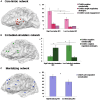Network integrity of the parental brain in infancy supports the development of children's social competencies
- PMID: 27369068
- PMCID: PMC5091682
- DOI: 10.1093/scan/nsw090
Network integrity of the parental brain in infancy supports the development of children's social competencies
Abstract
The cross-generational transmission of mammalian sociality, initiated by the parent's postpartum brain plasticity and species-typical behavior that buttress offspring's socialization, has not been studied in humans. In this longitudinal study, we measured brain response of 45 primary-caregiving parents to their infant's stimuli, observed parent-infant interactions, and assayed parental oxytocin (OT). Intra- and inter-network connectivity were computed in three main networks of the human parental brain: core limbic, embodied simulation and mentalizing. During preschool, two key child social competencies were observed: emotion regulation and socialization. Parent's network integrity in infancy predicted preschoolers' social outcomes, with subcortical and cortical network integrity foreshadowing simple evolutionary-based regulatory tactics vs complex self-regulatory strategies and advanced socialization. Parent-infant synchrony mediated the links between connectivity of the parent's embodied simulation network and preschoolers' ability to use cognitive/executive emotion regulation strategies, highlighting the inherently dyadic nature of this network and its long-term effects on tuning young to social life. Parent's inter-network core limbic-embodied simulation connectivity predicted children's OT as moderated by parental OT. Findings challenge solipsistic neuroscience perspectives by demonstrating how the parent-offspring interface enables the brain of one human to profoundly impact long-term adaptation of another.
Keywords: embodied simulation; mentalizing; oxytocin; parent-infant synchrony; parental brain.
© The Author (2016). Published by Oxford University Press.
Figures



References
-
- Allman J.M., Watson K.K., Tetreault N.A., Hakeem A.Y. (2005). Intuition and autism: a possible role for Von Economo neurons. Trends in Cognitive Sciences, 9, 367–73. - PubMed
-
- Ames D.L., Honey C.J., Chow M.A., Todorov A., Hasson U. (2014). Contextual alignment of cognitive and neural dynamics. Journal of Cognitive Neuroscience, 27, 655–64. - PubMed
MeSH terms
Substances
Grants and funding
LinkOut - more resources
Full Text Sources
Other Literature Sources

